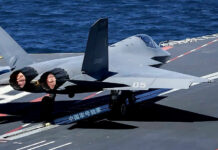
North Korea has moved the Rodong Intermediate-Range Ballistic Missile (IRBM) launchers closer to the South in an attempt to circumvent the missile defense shield soon to be established by the U.S. THAAD missiles.
North Korea maintains several ballistic missile bases throughout the country, strategically located to attack targets in the region.
The Kusŏng site, located in North P’yongan province houses Rodong missiles. These missiles target U.S. forces in Japan. Hwasong-5/6 (SCUD-B) missiles are based at the Kalgol-dong site located in Chagang province in the Northern region, north of pyongyang. Okp’yŏng-dong site is located in Kangwon province, Southeast of the capital, where both Hwasong and Rodong missiles. These missiles target South Korea. There are other numerous smaller sites, scattered around the country, serving for mobile launcher pads. The
The recent Rodong missiles tested by the North on the high-trajectory were launched from the base in Hwangju Province, some 45 kilometers south of the capital Pyongyang.

The missiles are reportedly positioned closer to the front demilitarization line, alongside the short-range Scud missiles. The missile is a copy of the Russian Scud C, locally produced in North Korea as ‘Rodong’ and as the ‘Shihab’ in Iran.
With a diameter of 1.25 meters and length of 15.6 meters the missile can throw a payload weight of one ton at a range of 1,000-1,300 km. In March 2014 Pyongyang tested these weapons in high-short trajectory and flew them to a range of 650 km. Their range was shortened by firing at a higher launch angle (up to 160 km, compared to 40 km of the Scud-type missiles). The high trajectory increased the missile’s speed of decent to 7 Mach terminal speed, thus avoiding interception by Patriot PAC-2/3 missiles.
North Korea is believed to possess some 300 Rodong missiles and fewer than 50 mobile launchers.
Analysts also warn that steep trajectory would also enable Pyongyang to deploy Electro-Magnetic Pulse (EMP) attack that would cripple electrical grid and electronics over a large area, using a small nuclear detonation high in the atmosphere.



















